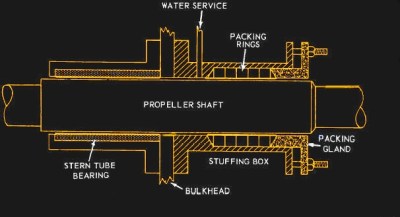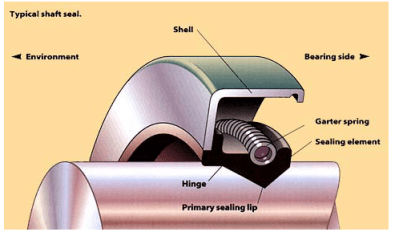On the face of it, keeping fluids contained seems like a simple job. Your fridge alone probably has a dozen or more trivial examples of liquids being successfully kept where they belong, whether it’s the plastic lid on last night’s leftovers or the top on the jug of milk. But deeper down in the bowels of the fridge, like inside the compressor or where the water line for the icemaker is attached, are more complex and interesting mechanisms for keeping fluids contained. That’s the job of seals, the next topic in our series on mechanisms.
Packing it In
One of the simplest seals is packing, or compressing some sort of flexible material into a space to control the flow of a fluid. Packing probably dates to at least the time when humans began making boats more complicated than a simple dugout canoe, in response to the fact that it’s really difficult to keep water from leaking between two pieces of wood. Ship seams have been caulked with fibers like hemp and cotton soaked in pitch or tar for millennia.

A more complex seal, in the form of a stuffing box around the tiller post of an inboard rudder, extended the concept of caulking into a more dynamic environment. A tiller post is a vertical shaft that penetrates the bottom hull of a vessel and connects the submerged rudder to a tiller or other steering gear. To staunch the flow of water through such a gaping wound, a stuffing box was built inside the hull around the shaft and packed full of old rope fibers, rags, bits of sailcloth — anything fibrous and compressible. Soaked with tallow or fat for lubrication and water repellency, the stuffing was compressed with a gland around the shaft that was tightened down under screw pressure or using wedges. Stuffing boxes are still used to this day for all kinds of shafts that penetrate a vessel’s hull, including where the propeller shaft exits the stern, in which case the assembly is called a stern gland.
Maritime tradition has stuck with compression packing. While far from perfect, compression packing seals are cheap and easy to engineer, and so still see service to this day. Compression seals are used in water pumps and as a seal around the pump shaft to keep the process fluid controlled. While the materials used have come a long way, with highly engineered Teflon and graphite packing replacing hemp and lard, the basic technique is still the same — squeeze the packing as tightly as possible around the shaft to make it hard for fluid to penetrate. Hard, but not impossible — compression packing always leaks to some degree. Packed joints therefore require constant maintenance, including frequent tightening of the gland to maintain compression and eventually replacement of the old packing with fresh material.
Sealing the Deal
Ongoing maintenance costs and the tendency of compression packing to wear out the shaft they are wrapped so tightly around are two of the biggest drawbacks to these seals, and so other types of seals for rotating shafts were invented. Your car engine has a ton of seals, but the ones that can cause you to have a really bad day when a mechanic tells you you’ve “blown a seal” are the crankshaft seals. There are usually two, one where the crankshaft exits the crankcase at the rear to connect to the transmission, and one at the front where the crank pulley that runs the water pump, alternator, and other engine accessories exits. Seals are needed around the crankshaft because the crankcase is full of oil; the seals keep the oil inside the engine while allowing the crankshaft to rotate and run the car.
Crankshaft oil seals are known as radial shaft seals or lip seals, where a flexible material is formed into a ring that fills a space between the stationary part (the crankcase in our example) and a rotating shaft (the crankshaft journal). Like compression packing materials, lip seals were once made from natural substances like leather, but today elastomeric substances like Viton and Buna N are used. Most modern oil seals are composite mechanisms, too, with the elastomer bonded to a metal case that can be pressed into a recess in a crankshaft in an interference fit.

Radial shaft seals seem simple enough, but there are several critical factors in designing a seal that’ll work. Aside from choices like material compatibility with the process fluids and heat ratings, the geometry of the flexible lip is crucial to the design. Looked at in cross-section, the lip forms a triangular profile with the apex touching the shaft at a single contact point. The angle of the lip on the wet side of the seal must be steeper than the angle on the dry side, so that hydraulic pressure from the process fluid (oil in our crankshaft example) tends to force the seal tighter around the shaft. Process fluid pressure is a major consideration as well — too much and the lip can deform enough to increase the contact area, causing premature wear and failure. That’s why we’re warned that too much oil in an engine can be just as bad as too little — more volume means more pressure, leading to the classic “blown seal” symptom of leaking from either the front or rear of the engine.
For viscous process fluids like grease, a plain elastomeric lip seal might suffice. But thinner fluids generally need extra circumferential force to help keep the lip in firm contact with the shaft. Such seals are likely to incorporate a garter spring into the lip to preload the seal on the shaft and to help make up for any irregularities in the shaft. Garter springs also help compensate for any radial oscillations of a shaft.
We’ve only touched on a few of the hundreds of types of seals for both dynamic and static applications here. The engineering behind them is pretty interesting, though, especially when you realize that it all started with a box of greasy rags.
Featured image source: American High Performance Seals
















Greater compression force needed for tighter seal is also friction’s normal force, so basically if seal doesn’t leak, it’ll dissipate power and heat up (which in turn might affect sealing). Therefore, like so many other things, permissible amount of leak is a trade-off.
Wankel engine.
I think you forgot to mention actual mechanical seals, you know the type with a silicon-carbide stationary face and a graphite spring loaded roaring face. Despite a single fingerprint on the mating surfaces can ruin the seal, they are very effective when installed correctly.
It was probably worth mentioning the labyrinth (labby) seal as well. It’s up there with packing as far as simplicity goes. It works by making your fluid navigate around many corners and reducing pressure around each to the point it can not make it all the way through.
Both of these seal types are very common in rotating assemblies and are worth looking into.
Autocomplete strikes again, it’s supposed to be rotating face not roaring face.
Sometimes it’s b the same thing actually.
Yep, labyrinth seals are also commonly used in turbo chargers
Quite interesting. I learned something new today.
I can say the same. Thanks for the article!
Interesting, thanks!
It’s worth noting that shaft technology has co-evolved with seal technology to get where we are. A modern shaft sealing area is turned true and ground to a very smooth finish, which helps seals prevent leaks and last longer. A modern high-tech seal would be worthless on an 19th century rudder post because the shafts were rough and crooked.
Everything is a system.
Very interesting observation re combination of new and old tech.
I recently watched some rough-made African scooters made completely from wood. Of course someone commented that they need real bicycles. But if they got them, they would be quickly destroyed by poor roads, and they could not be fixed by local people.
https://www.youtube.com/watch?v=OGVpI9NXTbU
So every tech needs supporting tech/society, or it is not sustainable.
https://bikesnotbombs.org/
The portion of shaft that the seal runs on is known as an oil seal land, if the land gets torn up by grit on the seal this can easily be repaired with a spedisleeve, an incredibly thin replacement land, these things have saved me a phenomenal amount of time and money over te last few years.
And there’s an old trick that involves cutting a hook-shape out of a plastic milk carton that you can work around the space between the seal and shaft to extract dust and grit and make it seal properly again. Massively easier than rebuilding front suspension forks and driving in new seals.
Good one Dan!
Uh-oh… is that [Bill Herd]’s Z car with the catastrophic seal failure?
I’ve found a couple interesting ones. BMW motorcycles use a teflon rear main seal with spiral grooves on the surface which mates against the crankshaft. The direction of the spiral causes surface friction from the spinning shaft to pump oil back into the crankcase instead of leaking out. They figured that this way, less pressure and therefore less friction could be placed on the shaft, reducing wear of both parts. It works pretty dang well, but an old one can buckle over and let air in when the pistons rise and create crankcase vacuum, making a reed-type noise known as “turkey gobble.” It’ a pain to diagnose if you don’t know what you’re looking for.
In the Honda CX500 there’s a compound mechanical seal on the end of the camshaft–which also drives the water pump. So here’s an engineering problem: you have an aluminum wall pierced by a shaft. On one side is low-pressure engine oil and mechanical bits. On the other side is a turbo-pump and a high-pressure, high-temperature mixture of water and antifreeze. How do you keep it from ruining the whole engine when the radial seal fails?
Honda designed a two-part seal, plus an empty channel in the middle with a drain. The inner seal is a normal radial seal, designed to support radial loads. The outer turbo-pump seal is actually axial, much like a thrust bearing. It’s designed to be pressed even tighter by the water and steam pressure. For this it needs ceramic parts, since rubber just wouldn’t work. So it’s got a little ceramic ring that looks just like a polo mint. You have to assemble it with dish detergent as a lubricant, and any oil at all on the mint will cause a leak–so you rinse it in acetone and wear gloves. The tiny chamber between the two seals has a drain hole which ought to be inspected and cleaned out often, because if it clogs you’re going to make a milkshake out of your engine oil and generally break everything. If the hole is clear and it’s leaking antifreeze, you know the pump-side seal has failed. Engine oil? The camshaft seal. It’s a fairly robust solution with graceful failure modes and diagnostic signals.
The engine of the John Deere 4010 (circa 1960) has small holes in the side of the block. Antifreeze (coolant) will leak out of these holes if the first cylinder to engine block seal fails. After the secondary seal is breached, coolant will get into the crankcase.
Robust and graceful, yes. But time takes it’s toll. And if you were the proud owner of the GL or Turbo model , replacing it was a serious endeavor. I remember the first time, sleeves rolled up, new seal in hand, then finding out I had to disassemble half the bike to get to it.
Oh yes. I replaced one not long ago. The strategy is to make a big job out of fixing all of the stuff in that rear cover when it’s time for a timing chain replacement. Chain, tensioner, water pump seals, and that god-awful starter clutch mechanism. Maybe the stator, too. But mostly that damn starter clutch; a brand-new one immediately starts failing as soon as you get the engine back in the frame.
It is nice that the engine doubles as the bottom frame member, so you can just drop it down instead of trying to finagle it out of a traditional frame. But it still kind of sucks.
I don’t know if Honda was the first but I doubt it, that’s a very common construction for engine driven pumps. A combination of the radial shaft seal Dan described and the actual mechanical seal from the title that he didn’t, but w8lid did in the comments. In practice the mechanical seal (after the first few minutes running in) does not leak (in a closed loop cooling water system without contaminants, for a seawater pump that can get sand in it they don’t last long) and the oil seal maybe a drop in a week. I just changed both seals for a pump after 12000 (not continuous) running hours and they were still sealing perfectly.
Most commonly the stern tube nowadays contains multiple sealing arrangements but comes down to radial shaft seals with header tanks to create oil back pressure, so the seal will always have equal pressure on both sides (because the draft of the ship is variable).
“so the seal will always have equal pressure on both sides (because the draft of the ship is variable).”
Even more so on a submarine!
B^)
On one side of anyways. The people side is much less tolerant of highly varying pressure.
Sounds very similar to the oil/coolant wall in my son’s Yamaha yz450. A shaft driven by the crankshaft pokes out of the crankcase to drive the coolant pump. Trouble is, the shaft is only supported on one end (the crankcase end), so the outer end of the water pump shaft tends to….. wobble around a bit, Which destroys the water pump seal.
Fortunately it’s a fairly simple fix, but not a long term fix, because the shaft is only supported at one end, which means the outer end of the water pump shaft tends to….. wobble around a bit, Which destroys the water pump seal.
Lather, rinse, repeat. Yeah, it’s really a racing bike, so you’re *supposed* to rebuild it after every race. but still…..
In the case of the pump I just overhauled the entire housing is bolted to the side of the engine, with a geared shaft sticking into the crankcase being driven by the gearwheel in there. Then the pump shaft is supported by two bearings, so it’s properly centered in its seal. Then the trick is just that the housing is exactly aligned and secured with fitting pins so that the gear will always be in the exact correct position. And the shaft doesn’t wobble.
We were happy to get a nod from HD for our logger paper recently (https://hackaday.com/2018/02/16/underwater-logging-for-science/) but actually kind of surprised that they used a picture of the electronics in the post, when probably the most significant innovation was coming up with a cheap DIY housing that used the pressure at depth to increase the strength of the seal: https://edwardmallon.files.wordpress.com/2018/02/fig6_logerhousings640px.jpg
It’s surprising how many underwater devices still use use whole-body screw mechanisms, which have the double problem of not adjusting to water pressure, and putting a lot of shear stress on the o-ring surfaces when they are closed up.
https://www.parker.com/literature/ORD%205700%20Parker_O-Ring_Handbook.pdf
All of our front loader washers have a seal and two bearings. When the seal is breached the bearings go real quick! Compounded by aluminum spider on steel parts in damp closed space.
Having a good seal is like a Kiss from a Rose ;)
Sealed with a kiss?
Better than a blown seal :-o
[youtube https://www.youtube.com/watch?v=3dfRZktrIlo&w=560&h=315%5D
That’s just a little ice cream.
Many car engines used simple oil slingers into the 1950’s. No seal at all, just a raised ring on the crankshaft with a circumferential groove in the block and bearing cap, with a drain hole in the cap. Oil that came out the back side of the rear main bearing flowed back to the slinger then was thrown into the groove to drain back to the pan.
Put in too much oil and some would leak out the back of the engine. Fail to change the oil often enough (wasn’t detergent type back then) and the drain would clog, causing a lot of oil to run out the back.
Just finished a head gasket changeout on a 1.9 l turbo diesel. With a compression ratio of 19.5:1, you’re dealing with a lot of mechanical and explosive forces for sealing hot gasses and fluids.
Now that a lot of new cars have electric power steering and electric water pumps, and some replacing the alternator with a permanent magnet type built into the CVT, wouldn’t that eliminate one of the big seals?
I had no idea! Thans for the cool writeup.